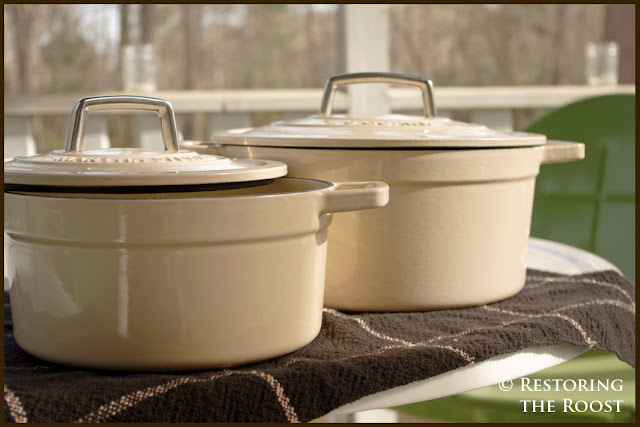I'm excited to show you our guest room today. It has been a challenge to decorate this room. We've been in this house for over three years now and I'm just now getting this room put together.
Before it was a hodgepodge of stuff, with no color palette or feel defining the room. This room to me is difficult due to the projection in the middle of one wall where a fireplace used to be, and a recess along that same wall. It's one lonely window also makes it odd in my mind. One of the first changes that I made was to paint the room from a pastel yellow to more of a neutral cream color. In hindsight I wish now I had painted it stark white for a crisper look.
Next I decided I wanted to spray paint our white iron bed red for a bold look against the white bedding. I draped my husband BJ's great-grandmother's quilt overtop. The room morphed into sort of a farmhouse-y look.
I seem to act very impulsively when it comes to decorating.....does anyone else have this problem?
Over time this room seemed to morph into the "chicken" room. I had chicken paintings, prints, signs, and other memorabilia, chicken figurines......oh dear. This was NOT the look I was going for to give guests a relaxing, inviting room in which to stay. I decided I needed to get rid of our large, solid wood drafting table (a nice piece, but not functional for us anymore) and most of the chicken clutter. I moved a bookshelf with all of my antique books into this room instead.
I painted the yard-sale dresser from its crusty (not pretty) white to a color with more pop. This subtle gray-blue worked well and is not unlike the color on the wooden filing cabinet used on the far side of the bed. I topped the dresser this with an antique ammunition box that has a wonderful patina; a vintage sewing kit completes the trio.
The next new piece introduced to the room was my cherry side table detailed in
this post. It makes a wonderful bedside table and gives some rich color against the light walls. It may not stay in this room, but for now it works. I placed a jug for water and a glass on a tray along with some fresh lavender sprigs for guests staying the night.
This is the guest room shortly after we moved in:
Here is the room now:
A bamboo roman shade dresses up the lone window a bit. Then it was time to embellish the walls: an antique tobacco basket defines the bed, along with some prints, a breadboard made from an old bourbon barrel, and a mirror.
We also have a luggage rack tucked away for when guests come that we can pull out for their use. I like this one with its metal frame and thick burlap panels (a recent Christmas gift).
Now for the part of the room that doesn't quite fit and for me is too cluttered. I didn't want to show you this part, but that wouldn't really be fair now, would it?
 |
| Add caption |
Currently this room has to do double-duty and also function as a space for BJ's music-related items including his keyboard, guitars, music books, and other items. I wish it could function as solely a room for guests and their relaxation, but that is just not possible at this time. So, one wall and cubby is devoted to musical pursuits.
BJ has been patiently waiting for his "man room" all to himself......maybe someday soon, honey :)
 |
| Add caption |
The cool thing is that he was able to easily build shelving in this nook to accommodate his books, musical supplies, art, and other random items that were taking up precious closet space elsewhere. It may not match the rest of the room, but at least the space is being used. This shelving cost us about $12 to build, having the paint and tools on hand already. I hope to post a tutorial soon on building this shelving--as it was so easy to do!
 |
| Add caption |
So there you are! Our guest room.
Linking to:
Savvy Southern Style Wow Us Wednesdays















































